2007 GMC ACADIA warning light
[x] Cancel search: warning lightPage 423 of 554
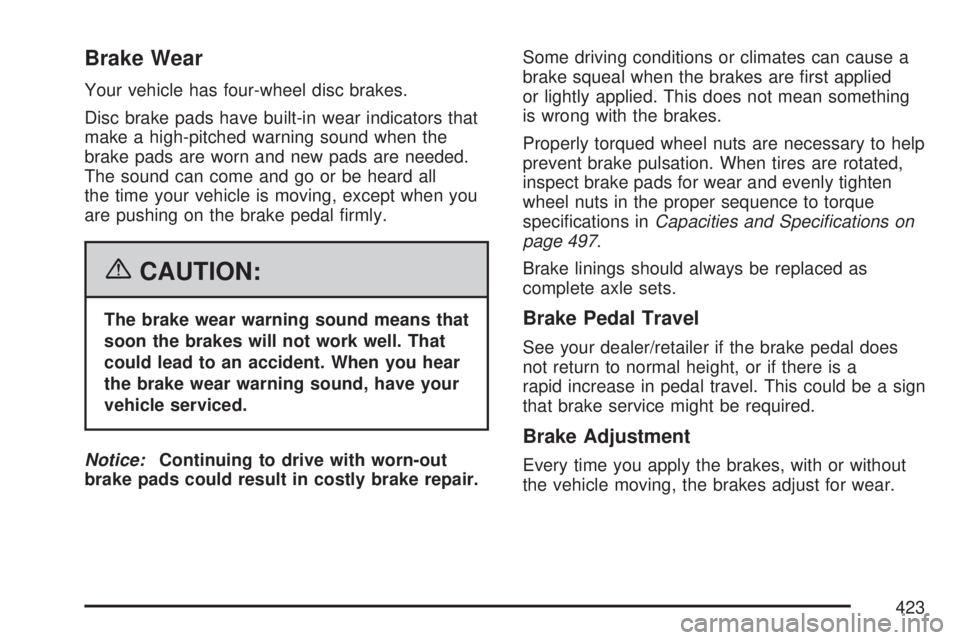
Brake Wear
Your vehicle has four-wheel disc brakes.
Disc brake pads have built-in wear indicators that
make a high-pitched warning sound when the
brake pads are worn and new pads are needed.
The sound can come and go or be heard all
the time your vehicle is moving, except when you
are pushing on the brake pedal �rmly.
{CAUTION:
The brake wear warning sound means that
soon the brakes will not work well. That
could lead to an accident. When you hear
the brake wear warning sound, have your
vehicle serviced.
Notice:Continuing to drive with worn-out
brake pads could result in costly brake repair.Some driving conditions or climates can cause a
brake squeal when the brakes are �rst applied
or lightly applied. This does not mean something
is wrong with the brakes.
Properly torqued wheel nuts are necessary to help
prevent brake pulsation. When tires are rotated,
inspect brake pads for wear and evenly tighten
wheel nuts in the proper sequence to torque
speci�cations inCapacities and Specifications on
page 497.
Brake linings should always be replaced as
complete axle sets.Brake Pedal Travel
See your dealer/retailer if the brake pedal does
not return to normal height, or if there is a
rapid increase in pedal travel. This could be a sign
that brake service might be required.
Brake Adjustment
Every time you apply the brakes, with or without
the vehicle moving, the brakes adjust for wear.
423
Page 444 of 554

Tire Pressure Monitor System
The Tire Pressure Monitor System (TPMS) uses
radio and sensor technology to check tire pressure
levels. TPMS sensors are mounted onto each
tire and wheel assembly, except the spare
tire. TPMS sensors monitor the air pressure in
your vehicle’s tires and transmit tire pressure
readings to a receiver located in the vehicle.
The TPMS is designed to alert the driver, if a low
tire pressure condition exists. If your vehicle has the
Driver Information Center (DIC), the driver can also
check tire pressure levels using the DIC.
When a low tire pressure condition is detected,
the TPMS illuminates the low tire pressure warning
symbol located on the instrument panel cluster.
If your vehicle has the DIC feature, a message
to check the pressure in a speci�c tire also
appears on the DIC display. The low tire pressure
warning symbol on the instrument panel cluster
and the CHECK TIRE PRESSURE warning
message on the DIC display appears at each
ignition cycle until the tires are in�ated tothe correct in�ation pressure. For additional
information and details about the DIC operation
and displays seeDIC Operation and Displays
(With DIC Buttons) on page 233orDIC Operation
and Displays (Without DIC Buttons) on page 239
andDIC Warnings and Messages on page 244.
You may notice, during cooler weather conditions,
the tire pressure monitor light, located on the
instrument panel cluster, and the CHECK TIRE
PRESSURE message appears when the vehicle
is �rst started and then turn off as you start to drive
the vehicle. This could be an early indicator that
the tire pressures are getting low and need to
be in�ated to the proper pressure.
Each tire, including the spare (if provided), should
be checked monthly when cold and in�ated to
the in�ation pressure recommended by the vehicle
manufacturer on the vehicle placard or tire
in�ation pressure label. (If your vehicle has tires of
a different size than the size indicated on the
vehicle placard or tire in�ation pressure label,
you should determine the proper tire in�ation
pressure for those tires.)
444
Page 453 of 554
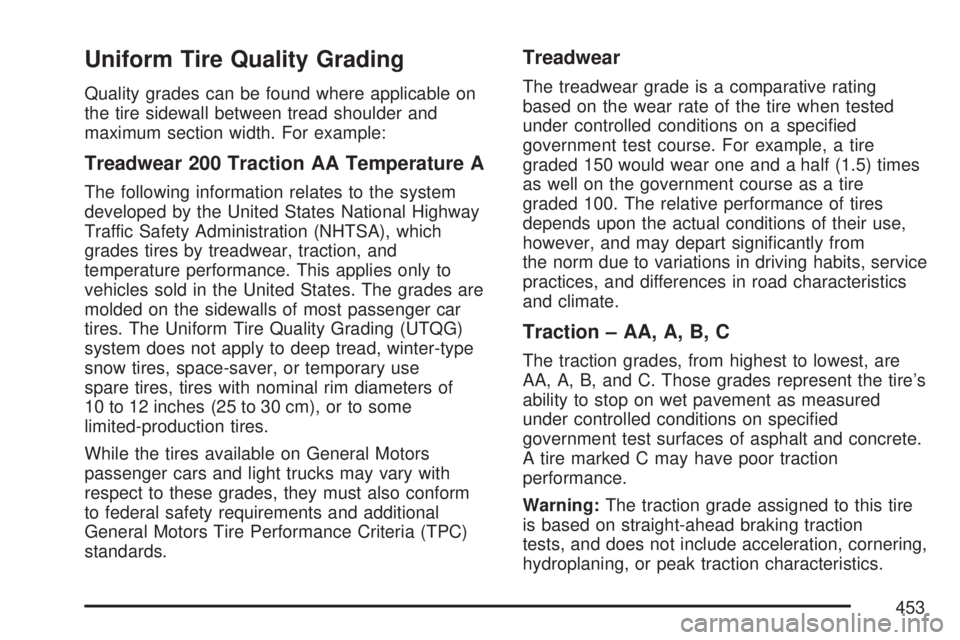
Uniform Tire Quality Grading
Quality grades can be found where applicable on
the tire sidewall between tread shoulder and
maximum section width. For example:
Treadwear 200 Traction AA Temperature A
The following information relates to the system
developed by the United States National Highway
Traffic Safety Administration (NHTSA), which
grades tires by treadwear, traction, and
temperature performance. This applies only to
vehicles sold in the United States. The grades are
molded on the sidewalls of most passenger car
tires. The Uniform Tire Quality Grading (UTQG)
system does not apply to deep tread, winter-type
snow tires, space-saver, or temporary use
spare tires, tires with nominal rim diameters of
10 to 12 inches (25 to 30 cm), or to some
limited-production tires.
While the tires available on General Motors
passenger cars and light trucks may vary with
respect to these grades, they must also conform
to federal safety requirements and additional
General Motors Tire Performance Criteria (TPC)
standards.
Treadwear
The treadwear grade is a comparative rating
based on the wear rate of the tire when tested
under controlled conditions on a speci�ed
government test course. For example, a tire
graded 150 would wear one and a half (1.5) times
as well on the government course as a tire
graded 100. The relative performance of tires
depends upon the actual conditions of their use,
however, and may depart signi�cantly from
the norm due to variations in driving habits, service
practices, and differences in road characteristics
and climate.
Traction – AA, A, B, C
The traction grades, from highest to lowest, are
AA, A, B, and C. Those grades represent the tire’s
ability to stop on wet pavement as measured
under controlled conditions on speci�ed
government test surfaces of asphalt and concrete.
A tire marked C may have poor traction
performance.
Warning:The traction grade assigned to this tire
is based on straight-ahead braking traction
tests, and does not include acceleration, cornering,
hydroplaning, or peak traction characteristics.
453
Page 539 of 554
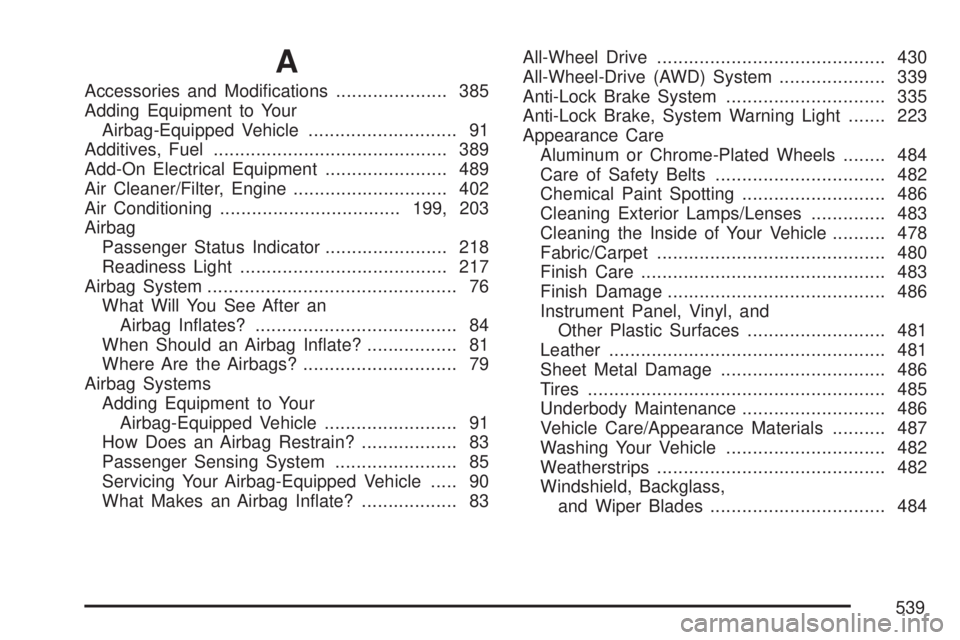
A
Accessories and Modi�cations..................... 385
Adding Equipment to Your
Airbag-Equipped Vehicle............................ 91
Additives, Fuel............................................ 389
Add-On Electrical Equipment....................... 489
Air Cleaner/Filter, Engine............................. 402
Air Conditioning..................................199, 203
Airbag
Passenger Status Indicator....................... 218
Readiness Light....................................... 217
Airbag System............................................... 76
What Will You See After an
Airbag In�ates?...................................... 84
When Should an Airbag In�ate?................. 81
Where Are the Airbags?............................. 79
Airbag Systems
Adding Equipment to Your
Airbag-Equipped Vehicle......................... 91
How Does an Airbag Restrain?.................. 83
Passenger Sensing System....................... 85
Servicing Your Airbag-Equipped Vehicle..... 90
What Makes an Airbag In�ate?.................. 83All-Wheel Drive........................................... 430
All-Wheel-Drive (AWD) System.................... 339
Anti-Lock Brake System.............................. 335
Anti-Lock Brake, System Warning Light....... 223
Appearance Care
Aluminum or Chrome-Plated Wheels........ 484
Care of Safety Belts................................ 482
Chemical Paint Spotting........................... 486
Cleaning Exterior Lamps/Lenses.............. 483
Cleaning the Inside of Your Vehicle.......... 478
Fabric/Carpet........................................... 480
Finish Care.............................................. 483
Finish Damage......................................... 486
Instrument Panel, Vinyl, and
Other Plastic Surfaces.......................... 481
Leather.................................................... 481
Sheet Metal Damage............................... 486
Tires........................................................ 485
Underbody Maintenance........................... 486
Vehicle Care/Appearance Materials.......... 487
Washing Your Vehicle.............................. 482
Weatherstrips........................................... 482
Windshield, Backglass,
and Wiper Blades................................. 484
539
Page 540 of 554

Audio System.............................................. 264
Audio Steering Wheel Controls................. 325
Care of Your CD and DVD Player............ 328
Care of Your CDs and DVDs................... 328
Navigation/Radio System,
see Navigation Manual......................... 311
Radio with CD......................................... 268
Rear Audio Controller (RAC).................... 324
Rear Seat Audio (RSA)............................ 322
Setting the Time...................................... 266
Theft-Deterrent Feature............................ 325
Understanding Radio Reception............... 326
Audio System(s)
Radio with CD and DVD.......................... 278
Automatic Transmission
Fluid........................................................ 404
Operation................................................. 129B
Battery........................................................ 424
Electric Power Management..................... 188
Run-Down Protection............................... 189
Before Leaving on a Long Trip.................... 352
Brake
Emergencies............................................ 336
Parking.................................................... 134
Brakes........................................................ 421
System Warning Light.............................. 222
Braking....................................................... 334
Braking in Emergencies............................... 336
Break-In, New Vehicle................................. 123
Bulb Replacement....................................... 432
Halogen Bulbs......................................... 432
Headlamp Aiming..................................... 431
High Intensity Discharge (HID) Lighting.... 432
License Plate Lamps................................ 433
Replacement Bulbs.................................. 433
Buying New Tires........................................ 450
540
Page 541 of 554

C
Calibration................................................... 140
California Fuel............................................. 388
California Proposition 65 Warning................ 386
Canadian Owners........................................... 3
Capacities and Speci�cations...................... 497
Carbon Monoxide..............110, 138, 356, 371
Care of
Safety Belts............................................. 482
Your CD and DVD Player........................ 328
Your CDs and DVDs................................ 328
Cargo Cover............................................... 163
Cargo Management System........................ 164
Cargo Tie Downs........................................ 163
CD, MP3 ............................................295, 301
Center Console Storage Area...................... 161
Chains, Tire................................................. 456
Charging System Light................................ 220
Check
Engine Light............................................ 226
Checking Things Under the Hood................ 394
Chemical Paint Spotting.............................. 486Child Restraints
Child Restraint Systems............................. 55
Infants and Young Children........................ 51
Lower Anchors and Tethers for Children..... 61
Older Children........................................... 48
Securing a Child Restraint in a
Rear Seat Position ................................. 69
Securing a Child Restraint in the
Right Front Seat Position........................ 72
Where to Put the Restraint........................ 60
Cleaning
Aluminum or Chrome-Plated Wheels........ 484
Exterior Lamps/Lenses............................. 483
Fabric/Carpet........................................... 480
Finish Care.............................................. 483
Inside of Your Vehicle.............................. 478
Instrument Panel, Vinyl,
and Other Plastic Surfaces................... 481
Leather.................................................... 481
Tires........................................................ 485
Underbody Maintenance........................... 486
Washing Your Vehicle.............................. 482
Weatherstrips........................................... 482
Windshield, Backglass,
and Wiper Blades................................. 484
541
Page 542 of 554
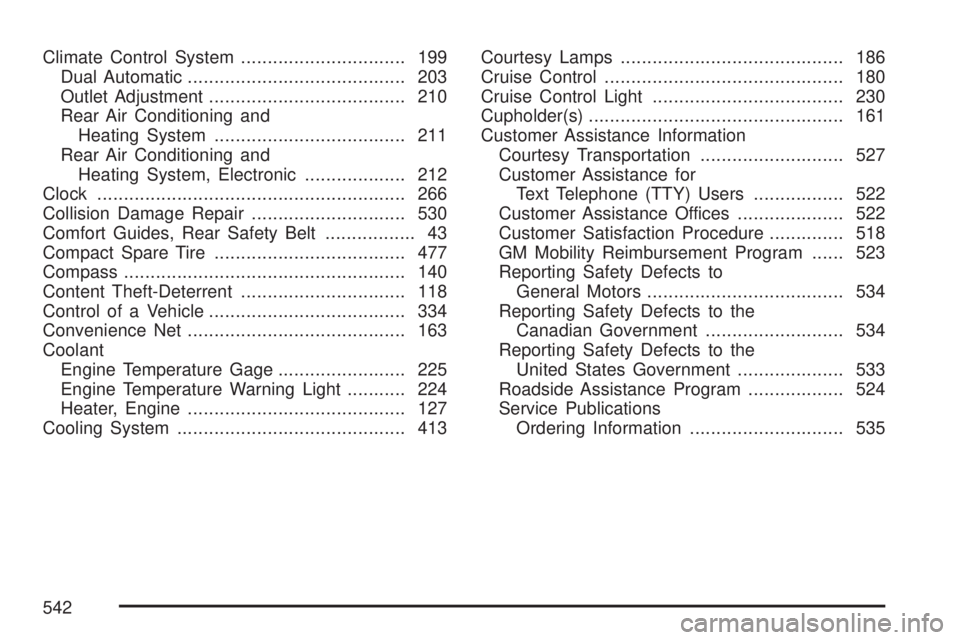
Climate Control System............................... 199
Dual Automatic......................................... 203
Outlet Adjustment..................................... 210
Rear Air Conditioning and
Heating System.................................... 211
Rear Air Conditioning and
Heating System, Electronic................... 212
Clock.......................................................... 266
Collision Damage Repair............................. 530
Comfort Guides, Rear Safety Belt................. 43
Compact Spare Tire.................................... 477
Compass..................................................... 140
Content Theft-Deterrent............................... 118
Control of a Vehicle..................................... 334
Convenience Net......................................... 163
Coolant
Engine Temperature Gage........................ 225
Engine Temperature Warning Light........... 224
Heater, Engine......................................... 127
Cooling System........................................... 413Courtesy Lamps.......................................... 186
Cruise Control............................................. 180
Cruise Control Light.................................... 230
Cupholder(s)................................................ 161
Customer Assistance Information
Courtesy Transportation........................... 527
Customer Assistance for
Text Telephone (TTY) Users................. 522
Customer Assistance Offices.................... 522
Customer Satisfaction Procedure.............. 518
GM Mobility Reimbursement Program...... 523
Reporting Safety Defects to
General Motors..................................... 534
Reporting Safety Defects to the
Canadian Government.......................... 534
Reporting Safety Defects to the
United States Government.................... 533
Roadside Assistance Program.................. 524
Service Publications
Ordering Information............................. 535
542
Page 543 of 554
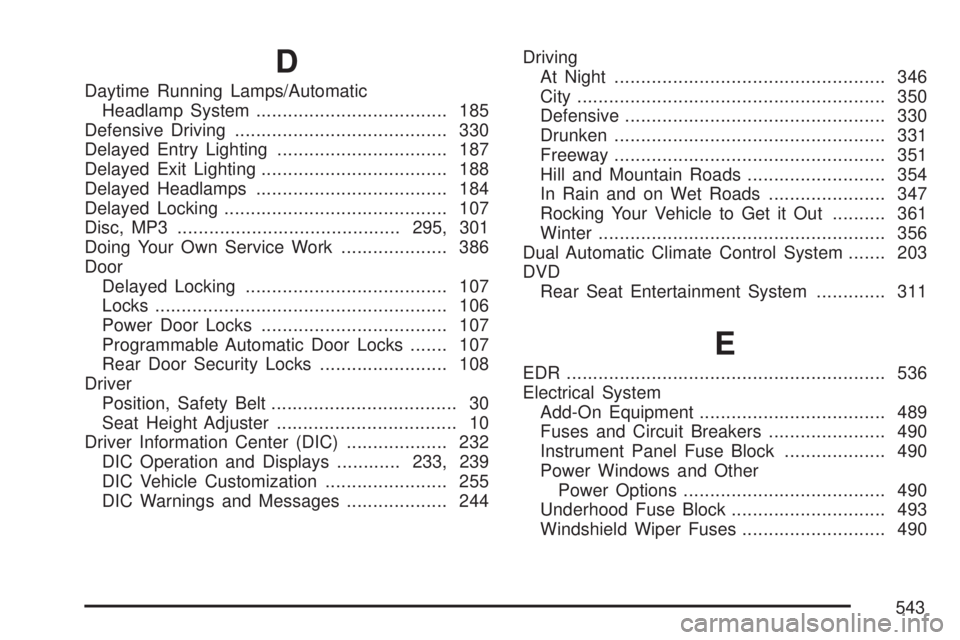
D
Daytime Running Lamps/Automatic
Headlamp System.................................... 185
Defensive Driving........................................ 330
Delayed Entry Lighting................................ 187
Delayed Exit Lighting................................... 188
Delayed Headlamps.................................... 184
Delayed Locking.......................................... 107
Disc, MP3..........................................295, 301
Doing Your Own Service Work.................... 386
Door
Delayed Locking...................................... 107
Locks....................................................... 106
Power Door Locks................................... 107
Programmable Automatic Door Locks....... 107
Rear Door Security Locks........................ 108
Driver
Position, Safety Belt................................... 30
Seat Height Adjuster.................................. 10
Driver Information Center (DIC)................... 232
DIC Operation and Displays............233, 239
DIC Vehicle Customization....................... 255
DIC Warnings and Messages................... 244Driving
At Night................................................... 346
City.......................................................... 350
Defensive................................................. 330
Drunken................................................... 331
Freeway................................................... 351
Hill and Mountain Roads.......................... 354
In Rain and on Wet Roads...................... 347
Rocking Your Vehicle to Get it Out.......... 361
Winter...................................................... 356
Dual Automatic Climate Control System....... 203
DVD
Rear Seat Entertainment System............. 311
E
EDR ............................................................ 536
Electrical System
Add-On Equipment................................... 489
Fuses and Circuit Breakers...................... 490
Instrument Panel Fuse Block................... 490
Power Windows and Other
Power Options...................................... 490
Underhood Fuse Block............................. 493
Windshield Wiper Fuses........................... 490
543